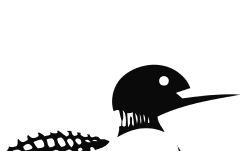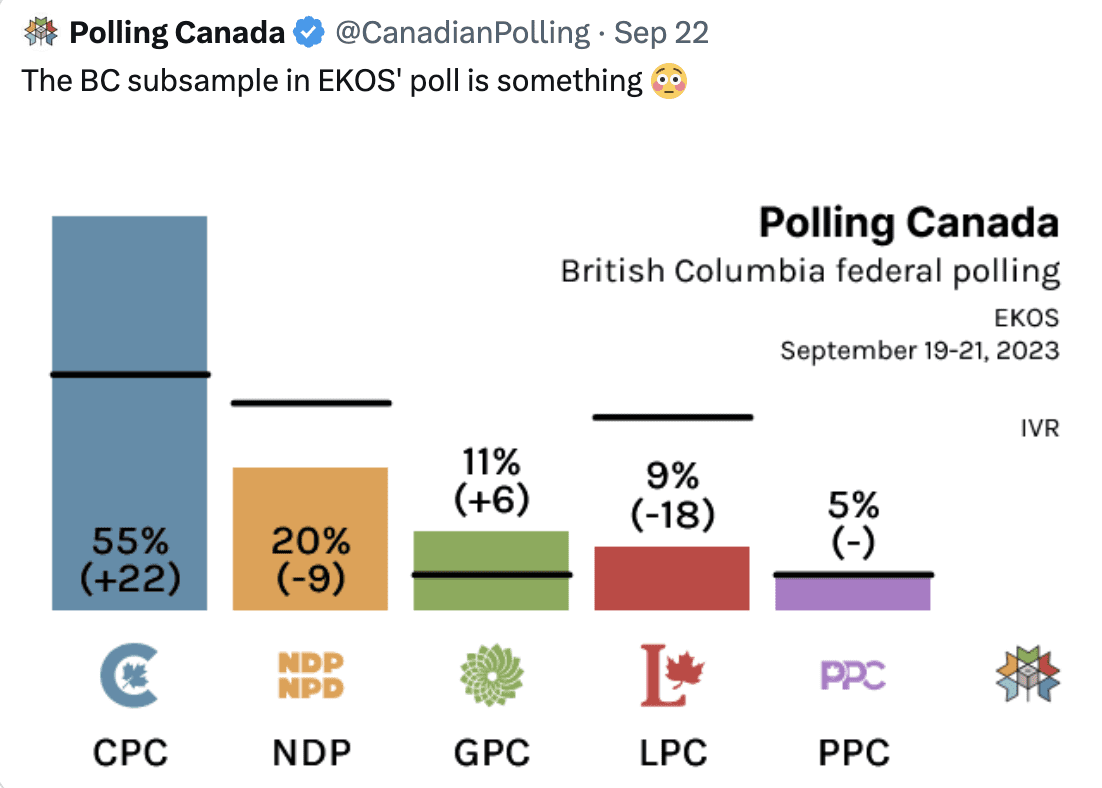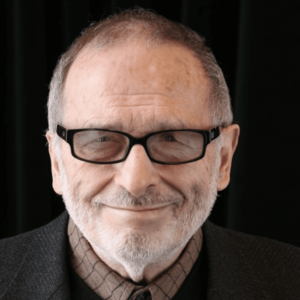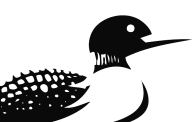In Canada as elsewhere autumn 2023 is a strange political time on various fronts. And it is not always easy to know just what to make of various opinion polling anomalies.
Take the case of two late September Canada-wide polls, broken down for federal parties in the third most populous province of BC, between the vast Pacific Ocean and the Rocky Mountains.
On the evening of September 28 the almost always interesting Polling Canada tweeted the BC provincial results of an EKOS federal poll taken September 19–24. As in the country at large this showed the Conservative Party of Canada (CPC) well out in front, with a remarkable 53% of the provincial vote. The NDP had 22% and the Liberal Party of Canada (LPC) only 12%.
At almost the same time, in the early morning of the same day Polling Canada had tweeted the BC provincial results of a Leger federal poll taken September 22–24. This proposed a rather dramatically different BC provincial picture: LPC 32%, NDP 30%, and CPC.29%.
With the confidence and supply agreement between Justin Trudeau and Jagmeet Singh in mind (both of whom have particular BC connections), these Leger numbers could be read to suggest that the province sometimes known as British California may have now become a progressive bastion in Canada, broadly comparable to Gavin Newsom’s California in the USA.
What all this could suggest about BC seems especially striking when set beside the Ontario results of the same Leger federal poll taken September 22–24: CPC 45%, LPC 28%, NDP 18%.
These Leger Ontario numbers look more like the EKOS numbers for BC. Partisans of the BC EKOS poll raise methodological issues with the Leger poll. On Twitter (now X), Polling Canada offers a methodological note on its BC Leger poll: “Sample size = 141 Online.”
Several commenting tweets urge this size is just too small. Yet 141 would be BC’s approximate share of the Canada-wide population in a cross-country sample of 1,000 people. And the EKOS poll whose results Leger poll critics like better has a Canada-wide sample of 1,025.
Methodologically, Polling Canada just notes “IVR” on its BC EKOS poll. And veteran polling guru Allan Gregg has quietly criticized “the interactive voice response (IVR) surveys that bombard telephone numbers with recorded questions which, quite frankly, isn’t any more scientific than … trying to stop people … on a street corner.”
Finally, in the technical rating of Canadian federal pollsters proposed by physics and astrophysics professor Philippe J. Fournier’s 338Canada website EKOS gets B+ and Leger A+!
All this having been said, there does remain an obvious enough sense in which less than 150 observations is not a very good sample size for political opinion polling.
Yet the insurmountable general problem here is that cross-Canada samples large enough to provide seriously reliable regional results are prohibitively expensive. (The average country-wide sample size of the most recent half-dozen polls followed by 338Canada is 1,385!)
The typical smaller-number, less reliable regional samples in Canada-wide polls are sometimes intriguing — and even revealing. But regional inconsistencies in these cost-effective soundings of Canadian opinion at large are not unusual. It is almost always wise to treat regional results of cross-country polls with grains of well-seasoned salt.
All this having been said again, there remains some further support for the Leger poll’s Canadian bastion of progress on the Pacific coast in recent polling on BC provincial politics.
338Canada’s latest model of a BC election held now shows the NDP with 71 seats, BC United (old BC Liberals) 11 seats, Greens 3, and Conservatives 2. In the early autumn of 2023 the progressive NDP BC provincial government — under new leader David Eby, but in office since the spring of 2017 — is arguably in greater command of provincial politics than ever before.
(And, it is tempting to wonder, is this somehow related to the 2023 wildfires?)
The ultimate truth probably is that both the recent EKOS and Leger polls reflect different strands in the complex web of BC provincial and federal politics. Both clusters of regional opinion are out there in the wet coast air.
The big question for the near-enough future is no doubt which of the two rather different late September 2023 BC polling pictures will prevail in the next federal election on or before October 20, 2025— EKOS’s conservative dominance or Leger’s progressive bastion? The answer could have something to do with the futures of both Justin Trudeau and Jagmeet Singh.






